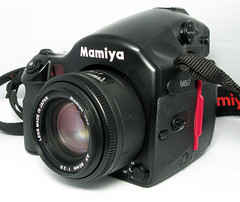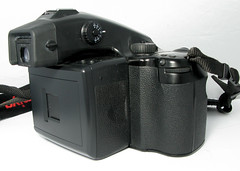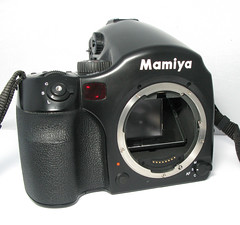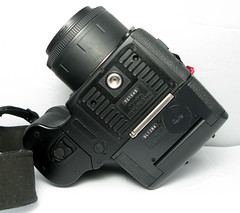Mamiya 645 AF and 645 AFD series

|
| 645 AF image by Rachel Rayns (Image rights) |
The 645 AF is a medium-format SLR camera made in Japan by Mamiya, the company's first autofocus camera. It was released in Japan in September 1999.[1] It was followed in December 2001 by the 645 AFD, a version of the same camera made compatible with some digital backs (not produced by Mamiya at the time), and Mamiya produced improved models, the 645 AFDII and 645 AFDIII later. These retain the ability to use either film or a digital back, switching from one to the other quickly, mid-roll if desired.
The cameras have a new bayonet lens mount incorporating several electrical contacts, to support the use of AF lenses. The lenses attach in the same way as with the previous mount, by aligning the lens with the red spot on the body and twisting to fasten the bayonet. The release is also unchanged; a sliding button on the left side of the camera body. The new mount is compatible, in a limited way, with the lenses for the preceding models (the Mamiya M645 and M645 Super series cameras). The manual-focus lenses can be fitted to the new mount, but the cameras do not have the pin to mate with the aperture yoke on these lenses, so stopped-down metering must be used. There is also a special focusing screen, with a manual-focusing aid (a microprism/rangefinder spot) for use with manual lenses.
645 AF
|
| ||||
|
| ||||
|
| ||||
Many of the features of the 645 AF are retained from Mamiya's previous series of 4.5x6cm SLR cameras /(the M645 Super and related models). However, the camera is not built in the modular way that those cameras were; the power film winder is built-in, as is the prism viewfinder; a waist-level finder cannot be used (although there is a right-angle eyepiece attachment).
As in previous camera series, the prism finder has settings for spot (S) or centre-weighted average (A) metering, and a setting (A-S) in which the camera automatically selects one or other of these, based on the variation in brightness in the scene. The meter measures between EV 2 (1 second at f/2) and EV 19 (1/2000 second at f/16) at ISO 100, and allows exposure compensation by up to three stops in either direction. The viewfinder eyepiece has a shutter to keep out light when the camera is used away from the eye, and built-in diotric adjustment.
Exposure settings are controlled via menu options displayed in an LCD on top of the winder grip, and selected with wheel controls (one by the shutter release button, and another at the back of the grip, by the user's thumb) in combination with a main mode dial. The expoure settings in use are also displayed at the bottom of the viewfinder. The mode dial has settings for metered manual exposure control (M), shutter-speed priority AE (Tv), aperture-priority AE (Av), programmed AE (P), auto flash (X) and a setting for long exposures (T). The shutter release button has settings for single or continuous exposures, and a locked position. It is threaded for a standard cable release. There is also a socket on the left side of the body for electronic releases.
The camera has a focal-plane shutter with aluminium blinds. This gives speeds from 30 seconds to 1/4000 second, in steps of 1/8 stop when in AE, or 1/2 stop when manually set. 'B' is available as a setting in the 'M' mode, and there is 'T' mode for very long expoures, as noted above. Both shutter blinds are automatically retracted (i.e. the shutter opens) when the film back is removed (to avoid damage to them) or when there are no batteries in the camera.
The auto-focus function is switchable between a single focus action, continuous re-focusing, and manual focus. The control is on the front of the body, at the bottom of the left hand side.
There is a hot shoe on top of the prism, as well as a PC socket on the left side. The camera is compatible with some Metz flashes for through-the-lens flash metering, with an adapter. The shutter synchronises for flash at 1/125 second.
The 120 film back for the 645 AF is superficially similar to that for the earlier M645 Super; it is a detachable chamber, with a metal dark slide, into which a film insert (comprising a pair of spool-holders with a pressure plate and rollers) can be fitted. However, the back for the 645 AF has an LCD to set and display the film type and speed (between ISO 25 and 6400), and requires its own battery (CR2032) to support this. It also has more electrical contacts than the earlier film back, and the two are not interchangeable. The same film insert accepts both 120 and 220 roll film; the pressure plate may be rotated, to adjust it for the different thickness of 120 and 220 film. The back automatically advances the film to frame 1 provided the paper leader is attached to the take-up spool. A Polaroid back also exists.
As with earlier models, the camera has a tripod socket which can be adjusted to ⅜ or ¼-inch size. There is a mirror-up lever on the left-hand side of the body.
The camera requires six AA batteries, which are loaded in a removable holder that fits into the grip. The LCD display shows the battery condition continuously when the camera is switched on (i.e. when the shutter release is not in the locked position). An external battery holder exists (to be kept in a pocket, for cold-weather use); this connects to a socket in the base of the camera.
645 AFD

|
| 645 AFD image by Tony Roman (Image rights) |
Notes
- ↑ Mamiya company history, in Japanese, on the Mamiya Digital Imaging website.
Links
User's manuals (pdf) at Mamiya USA:





